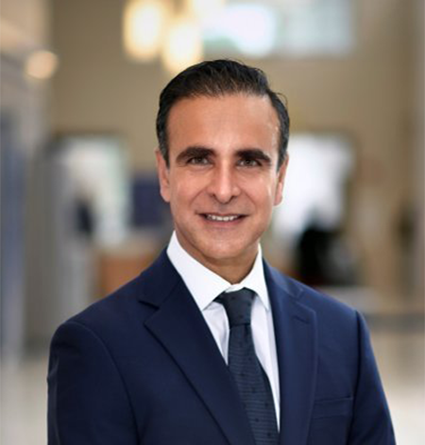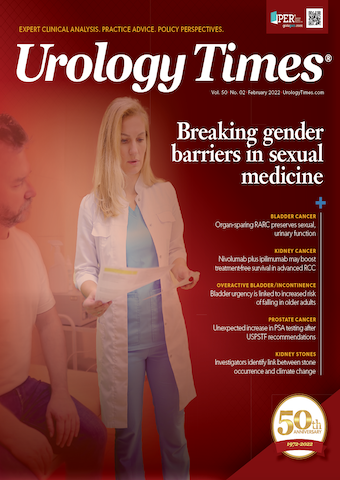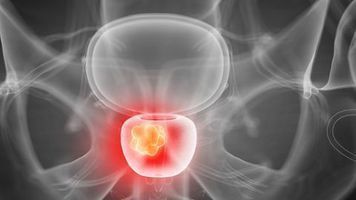Publication
Article
Urology Times Journal
Dr. Khera and Dr. Pearlman discuss innovations in testosterone therapy
Author(s):
Urology Times® is celebrating its 50th anniversary in 2022. To mark the occasion, we are highlighting 50 of the top innovations and developments that have transformed the field of urology over the past 50 years. In this installment, Amy Pearlman, MD, interviews Mohit Khera, MD, MBA, MPH on how advancements in testosterone therapy have changed treatment modalities across urology, providing patients with more efficacious, individualized care. Khera is a professor of urology and director of the Laboratory for Andrology Research, and director of the Executive Health Program at the McNair Medical Institute at Baylor College of Medicine in Houston, Texas. Pearlman is a clinical assistant professor of urology and the director of the Men’s Health Program at the Carver College of Medicine at University of Iowa Health Care in Iowa City, Iowa.
Amy Pearlman, MD

Pearlman: While there are so many innovations that have occurred, I think testosterone therapy is one of the greatest innovations that has not only occurred within urology, but perhaps within health care. So, in terms of testosterone and innovation, what makes this advent of testosterone therapy in men a top innovation in urology?
Mohit Khera, MD

Khera: When many patients think about testosterone, they think about bodybuilding and lifting weights, but the reality is that testosterone affects almost every facet of our body. Testosterone can affect our bones in terms of bone mineral density, it can affect cognition, muscle mass, fat deposition and depression. In addition, endogenous testosterone can affect fertility and the body’s ability to make sperm. We know testosterone is also important for erectile function and libido, [and] we know that it can help patients with anemia [by increasing] erythrocytosis in a positive way. So, there are many benefits of testosterone. We also know that testosterone stimulates stem cell production within the bone marrow. Testosterone is not just about bodybuilding and erections. It's really about all facets of men's health.
Pearlman: Let's talk about how testosterone therapy has been part of that innovation in urology. One of the biggest ways is how our thinking has changed in terms of its safety and efficacy in special populations. So, let's talk about the use of exogenous testosterone in men with prostate cancer.
Khera: So, I'll have to put this in the context of a story. When I started my residency in 2000, we were taught that testosterone was dangerous. In fact, [we were taught] that testosterone may increase the risk of prostate cancer recurrence, particularly in men who had a history of a prostatectomy. Slowly, after several publications, we started realizing that testosterone may not be as dangerous. And later on, we started seeing studies [come] out showing that testosterone may actually have a protective role. In other words, some studies demonstrated that those men who had normal testosterone levels were much less likely to have a biochemical recurrence than those patients who had low testosterone levels. In 2015, the most fascinating studies came out of John Hopkins by Dr. Denmeade's group, where they were using high doses of testosterone combined with [an] anti-androgen to treat men with metastatic prostate cancer.1 Can you imagine giving men with metastatic prostate cancer testosterone to help reduce the PSA and decrease metastatic disease? In fact, Dr. Denmeade’s group recently published a study this year called the TRANSFORMER trial, comparing enzalutamide [Xtandi], which is a treatment option in men with castrate-resistant prostate cancer, vs high doses of testosterone.2 What they found was similar efficacy between both treatments. So, again, really some paradigm-changing events that are going on with testosterone and prostate cancer.
Pearlman: And we were told that by adding testosterone to these regimens, it's like adding fuel to the fire. So, when it comes to testosterone and those with prostate cancer, really it's turned a 180. Completely different [and] no longer harmful, but perhaps protective in certain populations.
Khera: I agree. And I would say intuitively, I believe that. However, I just want to go back to the AUA guidelines. The 2018 [American Urological Association (AUA)] guidelines are very clear. The guidelines state that men should be notified that testosterone therapy does not increase the risk of prostate cancer—that is a strong recommendation by the AUA. However, the guidelines go on to state that in men with a history of prostate cancer [who have undergone] radical prostatectomy [and/or] radiation, the risk-benefit ratio has not yet been defined. In other words, we don't know. I will tell you that if you survey Urologists today, many Urologists are treating select patients with a history of radical prostatectomy and radiation. However I do think it is important to note that we do not have a randomized, placebo-controlled trial to fully assess the true safety.
Pearlman: Now, let's talk about testosterone in those with heart disease. So, something similar where our thinking about adding testosterone in these patients has completely changed. How has that been innovated over the last 50 years?
Khera: The paradigm has shifted. So, if you look at the literature before 2010, the majority of the studies suggested that giving testosterone to men did not increase the risk of a cardiovascular event. In fact, many of those studies demonstrated that giving testosterone may decrease the risk factors associated with a heart attack, such as diabetes, obesity, [and] metabolic syndrome. However, in 2010 to 2014, there were several studies that suggested that testosterone may increase cardiovascular risk. There were only 4 studies, and suffice it to say, there are some significant limitations with those studies. But since those studies, the FDA has requested, a large 6000-patient, randomized, placebo-controlled trial called the TRAVERSE trial. This study is expected to end in June 2022. The primary endpoint is [major adverse cardiovascular events], and I'm very excited about seeing the results of this study.
Pearlman: Now, lastly, let's talk about innovations with testosterone delivery and formulation. When you started, you said in the mid-2000s, what formulations were you using then and what are the options now?
Khera: The treatment options for testosterone have exploded over the past 20 years. When I started my practice, there were only 2 gels—we either gave patients Androgel, or we gave them Testim. That's all we had. We would also give patients injections, and some would use the patches., In 2008 came Testopel, [and] then soon after came AVEED —long acting injectables. We now have [a] tremendous amount of gels: intranasal gels, under-the-arm solutions,, inner thigh gels, and shoulder gels. We now have 1 oral testosterone medication in the market and a second one is set to come out in March of 2022. So, patients now have a lot of testosterone treatment options.
Pearlman: So, let's summarize here. When it comes to the last 50 years of innovations in urology and in health care, testosterone is definitely at the top. What I'm hearing from you is that it's drastically changed how we use testosterone in terms of special populations. And while the research is still ongoing, and we still have a lot more to learn, our initial thinking was wrong and that has changed even over the last 10 to 15 years. It’s an exciting field. And then, in terms of how we deliver testosterone, [there are] so many different options here. Is there anything else you want to add to that discussion?
Khera: I completely agree with you, and I think one important thing that we should always realize is that giving testosterone to men is a natural contraceptive. So, it's unfortunate, but many patients will come to our clinic with infertility and, someone has put them on testosterone. , Using testosterone can lead to infertility. There are medications that raise endogenous natural testosterone such as Clomid, HCG, [or] anastrozole. However, we also know that lifestyle modification can also increase natural testosterone levels, [like] losing weight. In fact, a 10% weight loss can increase serum testosterone by almost 95 ng/dL. A fifteen percent weight loss can increase serum testosterone levels by almost at 250 ng/mL.
Pearlman: I think the more important point is [that] the innovation is understanding that testosterone is critical, and whether it's giving someone exogenous testosterone or educating them in a way to help optimize their own testosterone production, perhaps that is the real innovation—just understanding the importance of hormones in men.
Khera: You're so right. And I believe that the way of the future is to help men raise their own endogenous testosterone in more creative ways. The most exciting studies I've seen are with stem cells.These studies look at taking Leydig stem cells, injecting them back into the testicular tissue and having that man, once again, produce his own natural testosterone. . I don't think we're far away and this is a very exciting field in testosterone.
Click to watch a video of Dr. Khera discussing the testosterone therapy advances
References
1. Schweizer MT, Antonarakis ES, Wang H, et al. Effect of bipolar androgen therapy for asymptomatic men with castration-resistant prostate cancer: results from a pilot clinical study. Sci Transl Med. 2015;7(269):269ra2. doi:10.1126/scitranslmed.3010563
2. Denmeade SR, Wang H, Agarwal N, et al. TRANSFORMER: A randomized phase II study comparing bipolar androgen therapy versus enzalutamide in asymptomatic men with castration-resistant metastatic prostate cancer. J Clin Oncol 39, no. 12 (April 20, 2021) 1371-1382. doi:10.1126/scitranslmed.3010563






























